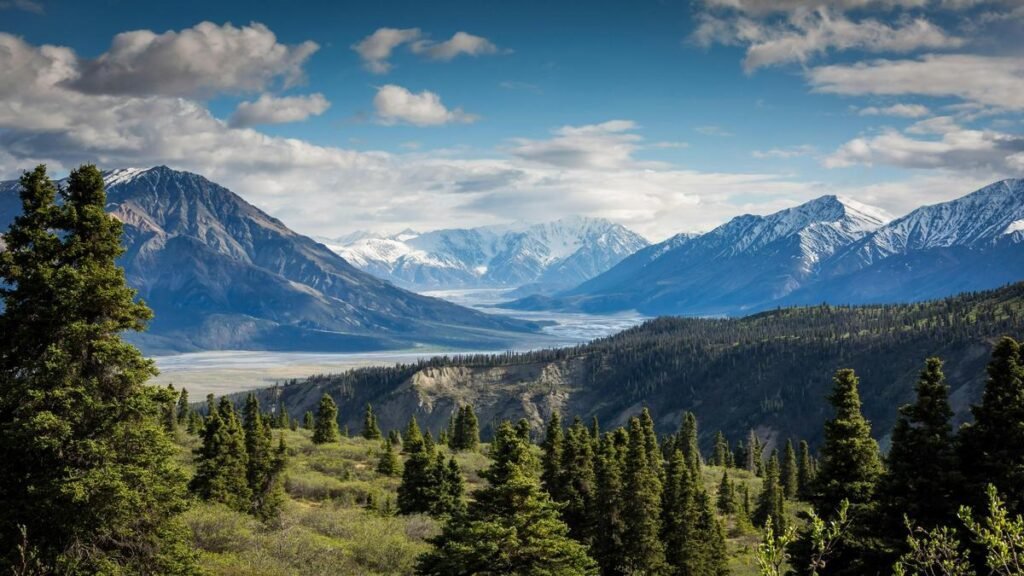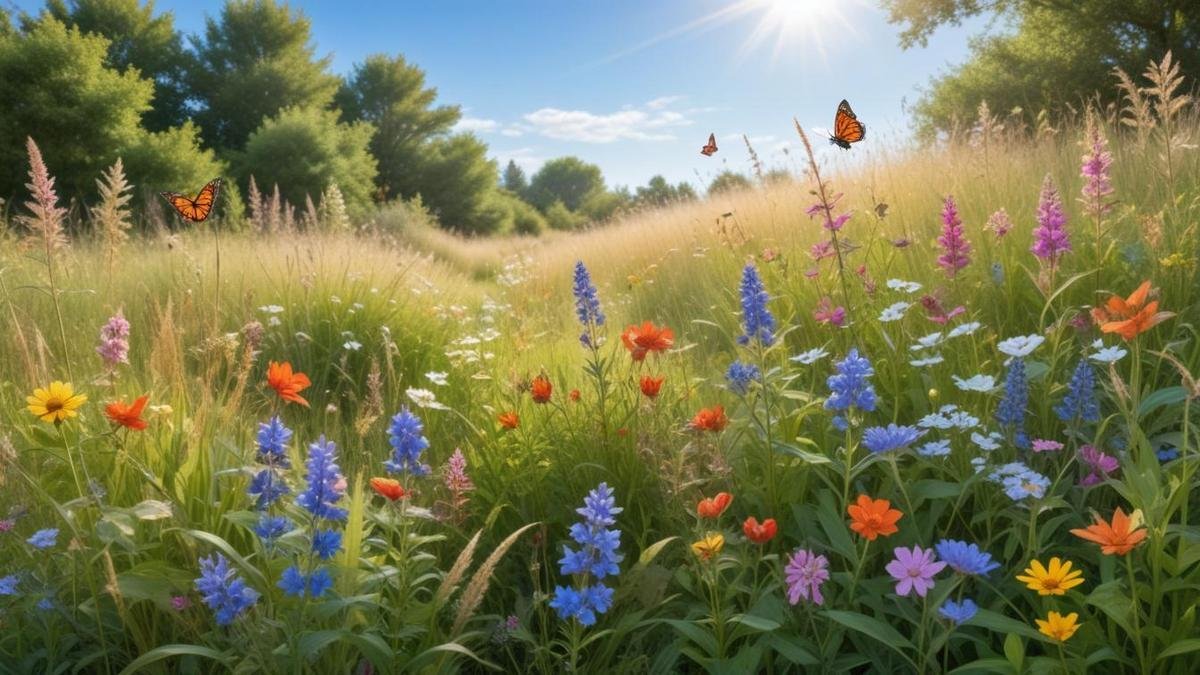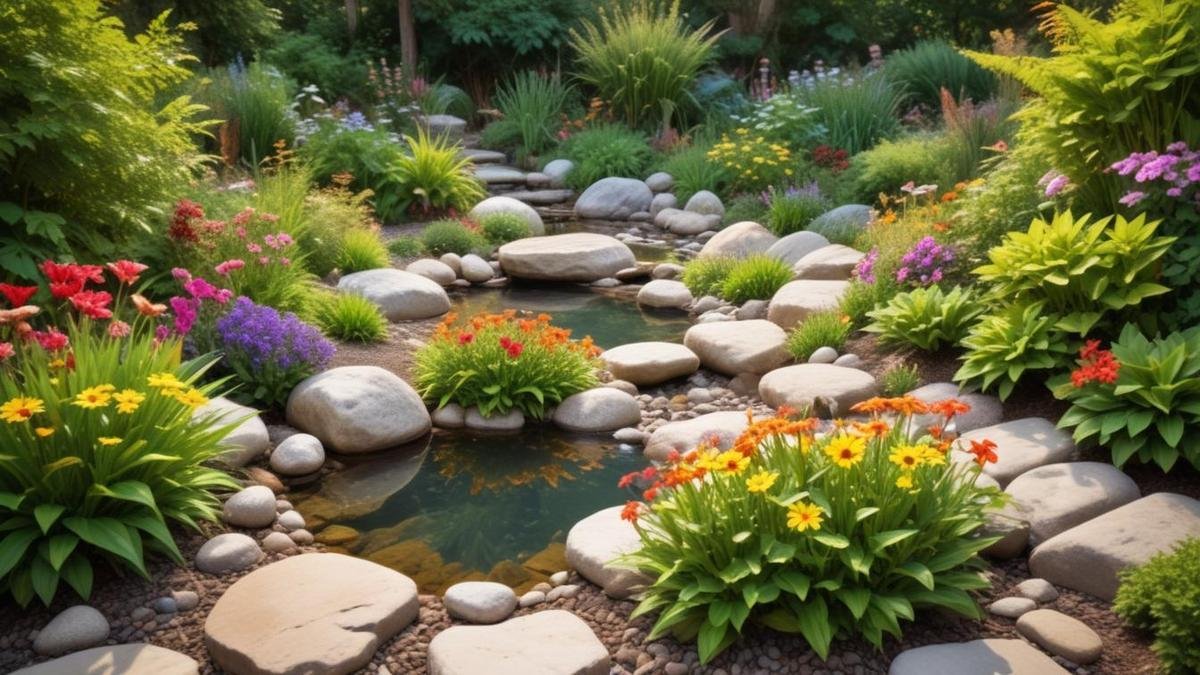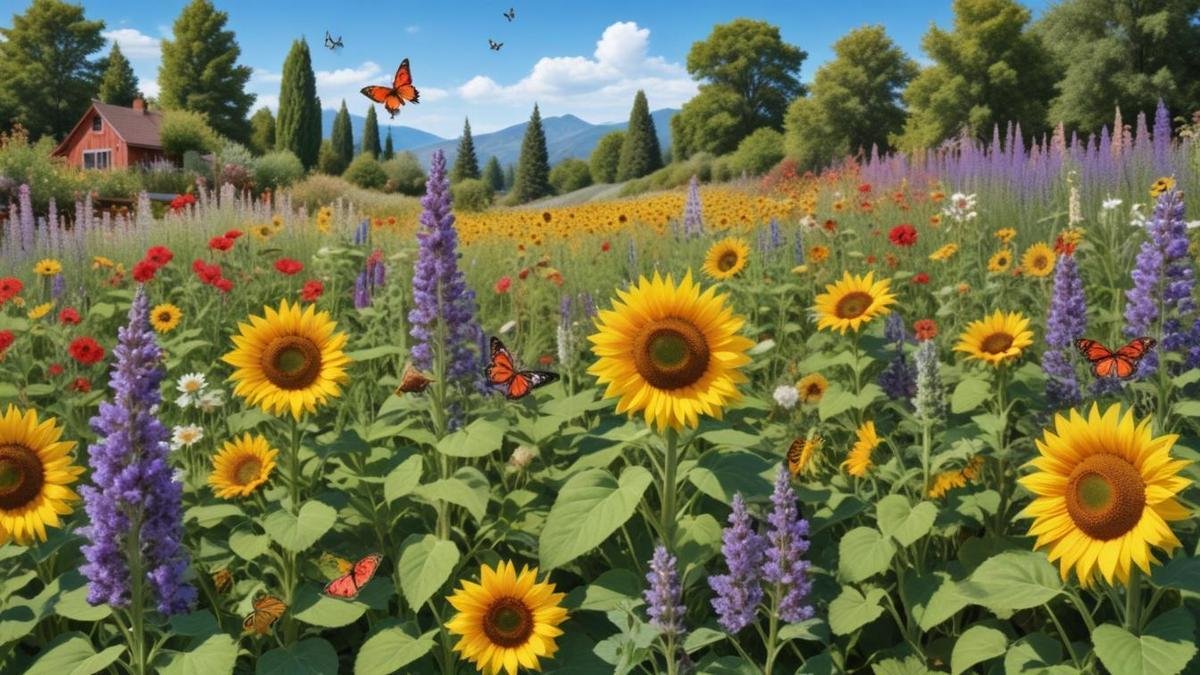
Creating a butterfly garden with native plants is a wonderful way to attract these beautiful creatures while helping our environment. In this article, you’ll discover what butterflies truly need to thrive, the essential elements for your garden, and how to choose the best plants. You’ll learn about landscaping techniques, water sources, and why native plants are amazing for butterflies and other pollinators. Let’s dive into how to create a butterfly garden with native plants to make your garden a fluttering paradise!
Important Points to Remember
- Choose native plants that attract butterflies.
- Provide sun and shelter in your garden.
- Add water sources, like a shallow dish.
- Keep the garden pesticide-free.
- Regularly check for caterpillars and eggs.

Understanding Butterfly Habitat Requirements
What Do Butterflies Need to Thrive?
Butterflies are beautiful creatures that add charm to any garden. To thrive, they need three main things: food, shelter, and water.
- Food: Butterflies feed on nectar from flowers. They love bright, colorful blooms. Native plants are the best choice because they attract local butterflies.
- Shelter: Butterflies need places to rest and hide from predators. Shrubs and tall grasses provide excellent cover.
- Water: Butterflies also need water. A shallow dish with stones or a small puddle can do the trick.
Essential Elements for a Butterfly Garden
Creating a butterfly garden is simple if you include the right elements. Here’s a quick table to help you out:
| Element | Description |
|---|---|
| Nectar Plants | Choose flowers like milkweed, coneflowers, and asters. |
| Host Plants | These are plants where butterflies lay eggs, like parsley and dill. |
| Sunlight | Butterflies love sunny spots, so pick a bright area. |
| Shelter | Include shrubs or tall plants for hiding. |
Creating Safe Spaces for Butterflies
Butterflies need safe spaces to thrive. Here are some tips to create those spaces:
- Avoid Pesticides: Chemicals can harm butterflies. Go natural with pest control.
- Provide Sunbathing Spots: Butterflies like to warm up in the sun. Flat stones can serve as perfect sunbathing spots.
- Create Windbreaks: Tall plants or fences can protect butterflies from strong winds.
Choosing the Best Native Plants for Butterflies
Top Native Plants to Attract Butterflies
If you want to create a butterfly haven in your garden, start with these top native plants. They’re like a magnet for butterflies! Here’s a quick list:
| Plant Name | Butterfly Species Attracted | Bloom Time |
|---|---|---|
| Milkweed | Monarchs | Late Spring |
| Coneflower | Swallowtails, Fritillaries | Summer |
| Black-eyed Susan | Various Butterflies | Summer to Fall |
| Aster | Painted Ladies, Skippers | Fall |
| Bee Balm | Hummingbird Moths, Monarchs | Summer |
These plants not only attract butterflies but also add beauty to your garden.
How to Select Plants for Your Butterfly Garden
Choosing the right plants is key. Here are some simple tips to help you select the best plants:
- Local is Best: Pick plants that are native to your area. They thrive better and support local butterflies.
- Diversity Matters: Include a mix of flowering plants. This will give butterflies food all season long.
- Consider Host Plants: Some butterflies lay eggs on specific plants. For example, Monarchs need milkweed for their caterpillars.
- Sunshine is Essential: Most butterflies love sunny spots. Choose plants that can bask in the sun.
Benefits of Native Plants in Your Garden
Using native plants has many benefits:
- Low Maintenance: They adapt well to local conditions.
- Supports Wildlife: They provide food and habitat for butterflies and other insects.
- Eco-Friendly: Native plants use less water and don’t need chemicals.
By planting native plants, you’re not just beautifying your garden; you’re also helping the environment.

Butterfly-Friendly Landscaping Techniques
Designing Your Garden for Butterflies
Creating a butterfly garden is like rolling out the red carpet for these beautiful creatures. Start by choosing native plants. Butterflies love them because they provide food and shelter. Here are some great options:
| Plant Type | Butterfly Attraction | Blooming Season |
|---|---|---|
| Milkweed | Monarchs | Summer |
| Coneflower | Various | Summer to Fall |
| Black-eyed Susan | Various | Summer |
| Aster | Various | Fall |
Mix these plants together to create a colorful display. Make sure to plant in clumps. Butterflies prefer larger patches of flowers rather than single plants scattered around. This makes it easier for them to find food!
Incorporating Water Sources in Your Butterfly Garden
Butterflies need water too! A small water source can be a game changer. You don’t need a big pond; a simple birdbath or shallow dish works wonders. Just fill it with fresh water and add some stones. This gives butterflies a place to land and sip. Ensure the water is shallow, so they won’t drown.
Here’s how to set it up:
- Choose a sunny spot in your garden.
- Fill a shallow dish with water.
- Add stones for butterflies to perch on.
- Change the water regularly to keep it fresh.
Using Natural Materials for a Sustainable Look
Using natural materials in your garden not only looks great but also helps the environment. Think about using stones, wood, and leaves. These materials blend well with nature. You can create pathways or borders using rocks or logs.
Here are some ideas:
- Stone Paths: They look nice and help with drainage.
- Wood Borders: Use old logs to define garden beds.
- Leaf Mulch: It keeps the soil moist and provides nutrients.
By using these materials, you’ll create a cozy home for butterflies. They’ll feel safe and happy in your garden.
Attracting Butterflies with Flowers
Best Flower Varieties for Butterfly Attraction
To create a butterfly haven, you’ll want to plant flowers that these beautiful creatures love. Here are some of the best flower varieties to consider:
| Flower | Color | Bloom Time | Notes |
|---|---|---|---|
| Milkweed | Pink, Orange | Summer | Essential for Monarch butterflies. |
| Coneflower | Purple, Pink | Summer-Fall | Attracts many butterfly species. |
| Black-eyed Susan | Yellow | Summer-Fall | Hardy and easy to grow. |
| Butterfly Bush | Purple, White | Summer-Fall | A magnet for butterflies! |
| Zinnia | Various | Summer-Fall | Bright colors and long blooming. |
These flowers not only look great but also serve as a dinner bell for butterflies. Mix and match these to create a colorful display that will draw them in.
Planting Strategies to Maximize Butterfly Visits
To really boost your butterfly traffic, consider these planting strategies:
- Group Flowers: Plant flowers in clusters. Butterflies are more likely to visit if they see a bunch of blooms together.
- Choose Native Plants: Native plants are like a welcome mat for butterflies. They thrive in your local conditions and attract local butterfly species.
- Create Sunny Spots: Butterflies love the sun! Make sure to plant in areas that get plenty of sunlight throughout the day.
- Provide Shelter: Add some shrubs or small trees nearby. This gives butterflies a place to rest and hide from predators.
The Role of Color and Fragrance in Attraction
Color and fragrance play a big part in attracting butterflies. Here’s how to use them to your advantage:
- Bright Colors: Butterflies are drawn to bright colors like yellow, orange, and purple. These colors catch their eye from afar.
- Sweet Scents: Flowers with a sweet fragrance can lure butterflies in. Think of flowers like lavender and jasmine.
- Variety is Key: A mix of colors and scents will create a butterfly buffet. The more options you provide, the more butterflies will come.

Gardening for Pollinators: More Than Just Butterflies
Creating a Pollinator Garden with Native Plants
Want to attract more than just butterflies? Native plants are your best friends! They are like a buffet for pollinators. When you plant them, you’re giving bees, hummingbirds, and other insects a place to feast. Here are some easy steps to get started:
- Choose Native Plants: Look for flowers that are native to your area. They are better suited for local pollinators.
- Plant in Clusters: Grouping plants together makes it easier for pollinators to find food.
- Mix It Up: Use a variety of colors and shapes. Different pollinators have different preferences.
| Plant Type | Pollinators Attracted | Bloom Time |
|---|---|---|
| Coneflower | Bees, Butterflies | Summer |
| Black-eyed Susan | Bees, Beetles | Summer |
| Milkweed | Monarchs, Bees | Summer to Fall |
| Aster | Bees, Butterflies | Fall |
Benefits of Supporting All Pollinators
When you support all pollinators, you’re doing more than just beautifying your garden. You’re helping the ecosystem thrive. Here’s why it matters:
- Food Production: Many fruits and vegetables depend on pollinators. More pollinators mean more food on your table.
- Biodiversity: A garden with various plants attracts different species. This keeps the environment healthy.
- Natural Pest Control: Birds and bats, which are also pollinators, eat pests. This means fewer chemicals for you!
Tips for a Diverse Wildlife Garden
Creating a diverse wildlife garden doesn’t have to be tricky. Here are some tips to keep in mind:
- Provide Water: A small birdbath can help. Pollinators need water to survive.
- Leave Some Wild Areas: Let part of your garden grow wild. This provides shelter for various creatures.
- Avoid Chemicals: Pesticides can harm pollinators. Use natural methods to keep pests at bay.
Sustainable Butterfly Garden Techniques
Eco-Friendly Practices for Your Butterfly Garden
Creating a butterfly garden is a delightful way to bring nature closer to you. Here are some eco-friendly practices to consider:
- Native Plants: Choose plants that are native to your area. They attract local butterflies and require less water and care.
- Companion Planting: Mix plants that benefit each other. For example, planting marigolds can help deter pests.
- Water Sources: Add a small puddle or birdbath. Butterflies need water, just like us!
- Avoid Pesticides: Instead of chemicals, use natural solutions like neem oil if pests appear.
- Mulching: Use organic mulch to keep the soil moist and healthy.
Maintaining Your Garden Without Chemicals
Keeping your garden thriving without chemicals is easier than you think. Here are some simple tips:
- Hand-Picking Pests: If you spot pests, simply remove them by hand.
- Beneficial Insects: Attract ladybugs and lacewings. They feast on harmful pests.
- Natural Deterrents: Use garlic spray or hot pepper spray to keep unwanted bugs away.
- Healthy Soil: Keep your soil rich with compost. Healthy plants can fight off pests better.
Long-Term Benefits of Sustainable Gardening
The long-term perks of sustainable gardening are truly rewarding. Here’s a quick look at some benefits:
| Benefit | Description |
|---|---|
| Biodiversity | Supports various species, including butterflies. |
| Soil Health | Rich soil leads to healthier plants. |
| Water Conservation | Native plants use less water. |
| Pollinator Support | Attracts bees and other helpful creatures. |
| Community Impact | Encourages others to garden sustainably. |
Frequently Asked Questions
What are native plants?
Native plants are species that grow naturally in your area. They are adapted to your local climate and soil. They’re great for attracting butterflies!
How do I choose the right native plants for my butterfly garden?
Look for plants that produce nectar and pollen. Check local garden centers or online resources for a list of native plants. Prioritize ones that attract butterflies.
How much space do I need for a butterfly garden?
You don’t need a huge area! Even a small patch can work. Just make sure it has enough sunlight and shelter for butterflies.
What else can I do to attract butterflies to my garden?
Add water features like shallow dishes. Plant host plants where butterflies can lay their eggs. Avoid pesticides – they can harm butterflies!
How to create a butterfly garden with native plants?
Start by choosing a sunny spot. Then, select a variety of native plants. Make sure to group them together for impact. Finally, maintain your garden by watering and weeding.
